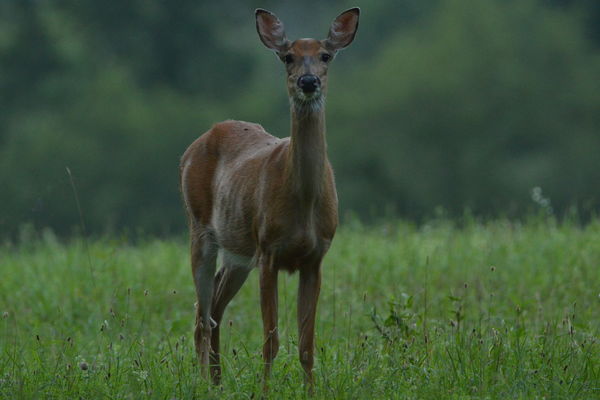Less than perfect conditions.
Aug 16, 2016 13:47:00 #
boehdick wrote:
Thanks RG, don't know the protocol. I'll get there.
It looks like you're getting the hang of it
 .
.Aug 16, 2016 19:25:54 #
Most of the replies have something to offer, but for me I completely understand the situation-shoot quick or get nothing. I usually shoot in aperture priority and lately have often used auto iso with good results (except when i want to bracket exposures). I really like your shot with the shallow dof. The eyes are tack sharp.
Aug 16, 2016 20:06:19 #
Thanks Warren, I often use aperture priority, but because salamanders have a habbit of getting away, auto became the goto. I do like the way the eyes pop out. Someone somewhere clued me into the notion of always getting the eyes in focus. Thanks for your kind comments. Just got back from a deer shoot so here is another question. Vertical or horizontal format? Enjoy, but tell me vertical or horizontal please.
WarrenT wrote:
Most of the replies have something to offer, but for me I completely understand the situation-shoot quick or get nothing. I usually shoot in aperture priority and lately have often used auto iso with good results (except when i want to bracket exposures). I really like your shot with the shallow dof. The eyes are tack sharp.
Aug 17, 2016 10:19:53 #
amfoto1
Loc: San Jose, Calif. USA
R.G. wrote:
I don't know where you're getting that idea from....
You and I are saying the same thing, I think. Please reread my original response.
To encapsulate:
Auto ISO with Manual = Good. But it's basically another form of auto exposure.
Auto ISO with Aperture Priority, Shutter Priority or Program = Bad. Any of these involve combining two different forms of auto exposure, really serve no purpose, and may not give predictable results.
I felt the earlier suggestion to use Auto ISO and Aperture Priority together was not a good one, wouldn't really accomplish anything and was recommending against it.
Auto ISO can be useful... but IMO is far overused and often misapplied.
Aug 17, 2016 10:25:38 #
amfoto1
Loc: San Jose, Calif. USA
boehdick wrote:
...Just got back from a deer shoot so here is another question. Vertical or horizontal format? Enjoy, but tell me vertical or horizontal please.
To me the 1st shot looks a bit oddly composed.
IMO, the second and third shots use the correct orientation for the subject.... Head-on looks better vertical/portrait, while photographed from the side the deer looks better in horizontal/landscape orientation.
All three are significantly underexposed... approx. least a stop.
(Note: You'd probably get more replies if you started a new thread with this new subject.)
Aug 17, 2016 11:54:31 #
amfoto1 wrote:
.....Auto ISO with Manual = Good.
Auto ISO with Aperture Priority, Shutter Priority or Program = Bad. .....
Auto ISO with Aperture Priority, Shutter Priority or Program = Bad. .....
Agreed. Perhaps "bad" is a bit strong, but it's better to do the thinking yourself and not let the camera make decisions for you. On the other hand, if somebody's working their way up the learning curve, A and S modes with auto ISO can help the learner concentrate on aperture and shutter speed one at a time, which probably makes it easier to get a handle on them. But it wouldn't do to make it a permanent habit.
Aug 17, 2016 11:58:28 #
boehdick wrote:
.......Vertical or horizontal format?.....
Both are equally valid and it depends on your intentions. Portrait orientation gives a more intimate shot but is lacking in context, whereas landscape orientation includes more of the surroundings.
Aug 29, 2016 22:26:02 #
R.G. wrote:
On the other hand, if somebody's working their way up the learning curve, A and S modes with auto ISO can help the learner concentrate on aperture and shutter speed one at a time, which probably makes it easier to get a handle on them.
I totally disagree. In amfoto1's first article the one part I disagree with was the idea that with two auto modes enabled you don't know what will happen, because you do know: it will always be the wrong thing!
AutoISO is great in manual mode.
Aug 30, 2016 01:28:09 #
Apaflo wrote:
I totally disagree. In amfoto1's first article the one part I disagree with was the idea that with two auto modes enabled you don't know what will happen, because you do know: it will always be the wrong thing!
AutoISO is great in manual mode.
AutoISO is great in manual mode.
A and S modes enable you to concentrate on the variables of exposure one at a time. Nobody's claiming that it'll guarantee perfect exposures all the time in all circumstances, but what it does do is enable you to get a handle on the different aspects of exposure one at a time. As a temporary stage in a learning process I'd say that has a lot going for it. What doesn't help is for beginners to be blitzed by an array of variables that all interact with each other, making it difficult to get a handle on any of it. I disagree with your comment that "it will always be the wrong thing". There will be times when it's less than perfect, but most of the time it's not going to give you seriously wrong settings (enough to spoil a shot).
I get the impression that you just don't appreciate the need some people have for a simplified learning process that enables them to get a handle on things one variable at a time. Even people that end up being good at using a camera would benefit from such a learning curve.
Aug 30, 2016 02:55:29 #
R.G. wrote:
A and S modes enable you to concentrate on the var... (show quote)
If you want to concentrate on Auto A or Auto S you need to turn AutoISO off. If it actually does anything at all it will not be the "right" thing because of what the other Auto has already done. It will not allow working with only one variable at a time, but instead moves two and you don't know what or why!
The easy and simple way to concentrate on aperture or shutter speed alone is with one and only one form of auto exposure enabled. Each can then be followed and the interaction is clear. I would again suggest Manual mode with AutoISO being the one Auto enabled.
If you want to reply, then register here. Registration is free and your account is created instantly, so you can post right away.





